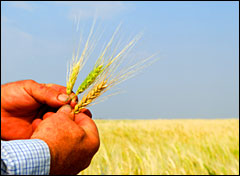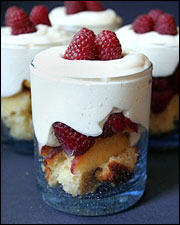
About 15 years ago, a friend brought an organic wine to a dinner party I was giving. He explained to me that in addition to being made from grapes that are grown organically, organic wines don’t contain any added sulfites (some sulfites occur naturally as a result of the fermentation process). Since I try hard to use organic products as much as I can afford to, I began to look for organic wines when I went shopping.
The choices were few and far between. Wine-industry people I knew seemed to hate the organic wine. They’d say, “Organic wine is awful! No winemaker in his or her right mind would make a wine without sulfites!”
Recently, however, I’ve seen more organic wines appear on the shelves, and I decided it was time to explore this topic in greater depth. So I visited the Boston Wine School to talk to Jonathon Alsop, the school’s founder and executive director, who kindly created a personal magical mystery tour of organic wines for me.
He set out a plate of cheese and bread as well as a small dish filled with shards of dark Taza chocolate to accompany the wines. We sat down and began our tasting as is traditionally done, moving from lighter selections to darker ones. First, though, Jonathon gave me a brief primer on organic wine.
Great Wine Starts in the Dirt
Wise vintners, Jonathon told me, make great wine by taking care of the land and the grapes and then “getting out of the way.”
“They know that a good wine is made in the vineyard,” he said. “These winemakers do everything they can to minimize the amount that they interfere with the natural processes that take place. They recognize that things like driving a tractor through the vineyard instead of doing work by hand will ultimately have a negative effect on the wine.”
He added that, like all farmers, winemakers can’t control the weather. When there’s more rain than usual, molds sometimes attack the vines, threatening the harvest unless a fungicide is used. Such seasonal vagaries make some vintners reluctant to seek organic certification, even when they generally use organic techniques.
Luckily for consumers, most really good wines come from winemakers who avoid agrichemicals as much as possible. “Winemaking doesn’t really lend itself to the practice of Big Ag, because whatever you do to the grapes you will ultimately taste in the wine,” Jonathon said.
Of course, some winemakers who use organic agriculture use sulfites in the winemaking process. Sulfites act as a preservative and keep white wines from changing to a golden or brown color. (They are not used as often in red wines.) The labels on these wines may say that they are made with organic grapes, but they do not — and, by law, cannot — identify the wines themselves as organic.
So the organic label is only one way to find wines that are grown with an eye toward ecologically minded practices. Another way to look for environmentally sound wines, Jonathon suggested, is to look for small-batch wines from a single vineyard.
Matter of Taste
After chatting, we tasted a few organic (and organic-ish) wines. We started with a 2005 Lolonis ($22) Chardonnay from Redwood Valley in California. Jonathon said that Madge Lolonis runs her vineyard in a completely organic way. The wine has a ladybug on the label, reflecting the fact that they shun pesticides and instead practice integrated pest management involving beneficial insects. The wine showed a crisp yet not overly sharp lemon-lime flavor. It actually kind of reminded me of 7-Up. I tend to prefer the more “buttery” style Chardonnays, but I can easily imagine finding this one refreshing on a hot summer day.
Next, we sampled a 2005 Domaine Montanet-Thoden Bourgogne ($22), a Pinot Noir from France’s celebrated Burgundy region. Its major flavors are Bing cherry, cranberry, and raspberry, commonly described as tangy, garnet berry flavors. We paired it with some Humboldt Fog blue cheese and some Brebis, a sheep’s milk cheese. The wine and cheeses interacted beautifully, each enhancing the other.
Next we moved to a California-made sample, Trader Joe’s Organic Syrah ($5.99). It tasted deliciously of jam and white and black pepper. Note the price — a glass only costs you $1.20! Mulling over a sip, Jonathon observed that “This is the golden age of great, tasty cheap wine.”
We then moved on to Parducci ($11.99) from a Petite Sirah grape. The wine was dead black — so dark and opaque that you can’t even see through it. It was dry and lacked any sweetness whatsoever (it reminded me of unsweetened cocoa powder) but it remained really drinkable despite the dry quality. I wanted to play with it with my tongue the way that I used to play endlessly with a loose tooth when I was seven. It tasted of aluminum, minerals, and stones — and I mean that in a good way. I rarely eat red meat, but this wine made me desperately crave a great big slab of prime rib, Yorkshire pudding to sop up the juices, and even plum pudding for dessert. It’s the perfect wine for a winter holiday dinner.
A 2005 Treana Red ($35-$40), a blend containing mostly Cabernet Sauvignon grapes, was next. The wine had a pleasing, almost chewy mouthfeel. Jonathon described its texture as almost like superfine sandpaper on the tongue. I was knocked out by the taste. I wouldn’t exactly call it sweet, but I longed to use it to flavor an egg custard or as a sauce for an egg custard, because I thought it would provide a deep, red-fruit flavor contrast to the sweet, mild, creamy taste and texture of the custard.
That’s not going to happen, though; this is no budget-priced cooking wine. Oh, well! At least I experienced the brief thrill of feeling inspired to cook with it! (Actually, if I could buy just one glass for $8 I might use it to make a dessert for a fancy dinner party for four people, but, of course, you can’t buy just one glass for $8.)
My custard-planning prayers were answered, however, when we tasted the last wine in the lineup, Rosenblum’s 2004 Black Muscat Gallagher Reserve ($18), a dessert wine from Alameda, Calif. It tasted like super-ripe plums — “a plum so ripe that it’s about to go bad,” Jonathon elaborated. Imagine the gooeyest, sweetest Passover wine that you’ve ever had — and now imagine what it would taste like if it were good! That’s how this wine struck me. And it’s priced low enough for me to consider using a glass for cooking — as I did when making the following dessert.
Syllabub
This rich, wine-flavored dessert is a traditional English favorite that lost favor with the advent of ice cream. In its original form, it could only be made on a farm: you would combine wine, cider, or ale in a bowl with sugar, spices, and citrus zest — and then hold the bowl under a cow’s udder to add fresh milk! Modified for the modern cow-free kitchen, it remains a delicious way to bring wine’s flavor to the after-dinner table.
Serves 4
1/2 cup Muscat wine
2 tablespoons sugar
2 or 3 teaspoons of grated orange zest
4 medium peaches or 6 small peaches
A few cubes of sponge cake, pound cake, or torn ladyfingers (optional)
Chill the bowl and beaters in preparation for whipping the cream. Ten minutes in the fridge should do the trick. Set out four glasses into which you will place the peach slices and spoon the syllabub. If you plan to use cubes or cake or torn ladyfingers, distribute them among the four glasses now.
Mix the cream, wine, sugar, and orange zest in the chilled bowl and then whip the cream until it holds soft peaks.
Peel and slice the peaches. Put half the slices from one peach on the bottom of a glass and then add about 1/4 of the syllabub mixture. Put the rest of the slices from the peach on top of the syllabub. (If you are using six small peaches, then add some extra slices from the extra peaches now.)
Serve immediately.



